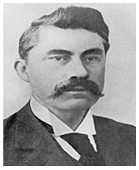Martinus Beijerinck was a Dutch microbiologist and botanists who like Sergei Winogradsky began examining the role of non-infectious microorganisms in the soil. They both reported that microorganisms play important role in nutrient recycling in the ecosystem (particularly those of nitrogen, carbon and sulphur) as well as in the process of nitrogen-fixation by symbiotic or free-living soil bacteria.
Martinus Beijerinck showed in 1888 that some beneficial microbes in the soil (e.g. Rhizobium) inhabit the root of leguminous plants and provide such plants with functional nitrogen through the process of nitrogen fixation. He also discovered viruses and sulphate-reducing bacteria. Beijerinck began his work by studying the microorganisms that were present in and around plants, and he soon began experiments with microbes in the soil which led him to develop enrichment media for culturing microorganisms.
Before Beijerinck’s discovery of the enrichment media, microorganisms were previously were cultivated on medium consisting of potatoes or extracts of leftover animal renderings which supported the growth of many different bacteria, with chance and population density dictating what became dominant in the culture medium. He discovered that by adding or removing certain compounds from the medium or incubating under different conditions, it was possible to favor the growth of certain microbes and prevent the growth of others.
His invention of the enrichment culture enabled him to isolate many microorganisms in their pure state including Azotobacter chroococum, sulfur-reducing and sulfur-oxidizing bacteria, Lactobacillus species, and green algae. He referred to this methods as selective culture techniques – which have since then been applied to many different groups of microorganisms, allowing them to easily be brought into pure culture forms.
Winogradsky and Beijerinck also provided the first evidence that viruses were infectious agents, their works in the area of soil microorganism’s which referred microorganisms as geochemical agents awaked great enthusiasm for identifying and classifying the bacteria inhabiting our natural world particularly the soil. And today, there is a branch of microbiology known as geomicrobiology which studies microorganisms that are of relevance to the geological or environmental significance.
References
Barrett J.T (1998). Microbiology and Immunology Concepts. Philadelphia, PA: Lippincott-Raven Publishers. USA.
Beck R.W (2000). A chronology of microbiology in historical context. Washington, D.C.: ASM Press.
Brooks G.F., Butel J.S and Morse S.A (2004). Medical Microbiology, 23rd edition. McGraw Hill Publishers. USA. Pp. 248-260.
Slonczewski J.L, Foster J.W and Gillen K.M (2011). Microbiology: An Evolving Science. Second edition. W.W. Norton and Company, Inc, New York, USA.
Summers W.C (2000). History of microbiology. In Encyclopedia of microbiology, vol. 2, J. Lederberg, editor, 677–97. San Diego: Academic Press.
Talaro, Kathleen P (2005). Foundations in Microbiology. 5th edition. McGraw-Hill Companies Inc., New York, USA.
Wainwright M (2003). An Alternative View of the Early History of Microbiology. Advances in applied microbiology. Advances in Applied Microbiology, 52:333–355.
Willey J.M, Sherwood L.M and Woolverton C.J (2008). Harley and Klein’s Microbiology. 7th ed. McGraw-Hill Higher Education, USA.
Discover more from #1 Microbiology Resource Hub
Subscribe to get the latest posts to your email.



